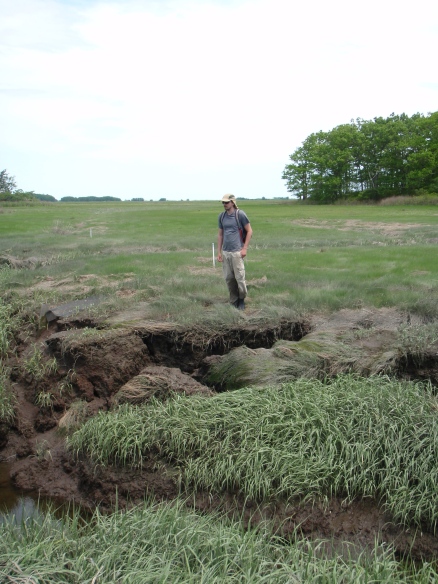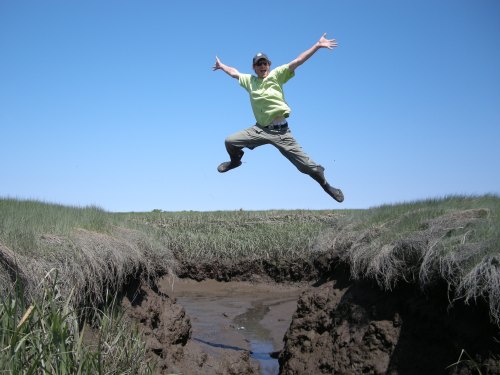It’s official: The TIDE Project has been re-funded by the National Science Foundation until 2016.
The TIDE Project will continue its fertilization experiments to look at the effect of chronic nutrient enrichment of salt marshes. We will focus on our most compelling finding to date: nutrients can lead to marsh loss. This result is compelling because while scientists have identified a number of causes of marsh loss, nutrients had never been identified until now. In that vein, we will focus on three major questions going forward:

The author contemplates, what’s causing the marsh to fall apart? What will it look like in the future? How will that affect marsh benefits to humans? Photo: Konner Lockfield
1) What are the biological mechanisms leading to marsh loss?
We hypothesize that changes in microbial activity (leading to increased decomposition) and reductions in root biomass have led to less cohesive creek banks, thus making them susceptible to physical forces and slumping. We will test our biological hypotheses to understand how nutrients can lead to marsh loss.
2) How does marsh loss affect ecosystem services?
All ecosystems provide benefits to humans and those benefits are called ‘ecosystem services’ by scientists. Two services provided by marshes include fisheries support and pollution control (i.e., nutrient removal). We will test the hypothesis that marsh loss reduces marsh ecosystem services by reducing the ability of the marsh to produce forage fish (the mummichog Fundulus heteroclitus) and to remove nutrients.
3) What is the eventual shape of the marsh with chronic nutrient enrichment?
What we have seen in the short-term is marsh loss that has led to sharp scarps (walls) which can affect a number of marsh functions (and in turn marsh services). It is unknown, however, if the marsh edge will continue to erode or stabilize in a different configuration (say, a low sloping edge). We will monitor changes in the geomorphology of the tidal creeks to predict the trajectory of these changes.
Collectively, the TIDE Project will answer interesting scientific questions while simultaneously addressing the critically important issue of the loss of marshes and the benefits they provide to humans (storm protection, pollution control, fisheries production, beauty).
The TIDE Project is led by Dr. Linda Deegan of the Marine Biological Laboratory (MBL). The team includes Dr. Sergio Fagherazzi (Boston University), Dr. Jen Bowen (UMASS-Boston), Dr. Tom Mozdzer (Bryn Mawr), Dr. Bruce Peterson (MBL), Dr. Anne Giblin (MBL), Dr. Jimmy Nelson (MBL) and Dr. David Johnson (MBL).
Like the salt marsh itself, the TIDE Project has been productive hosting almost 150 scientists, 70% of which have been young scientists, publishing over 40 scientific articles, and contributing to numerous outreach activities. We look forward to another set of productive years.
Thank you to the readers for all of your support. To learn more about the TIDE Project, go to our project site: http://www.mbl.edu/tide
David Samuel Johnson is a scientist at the Marine Biological Laboratory and loves spineless animals.

Wonderful news! I look forward to all of the tide project post.